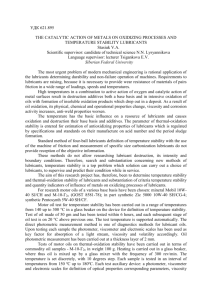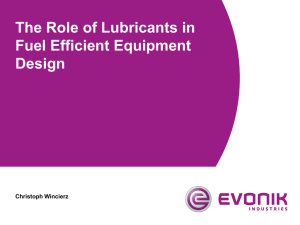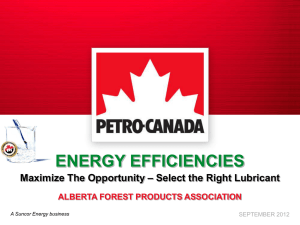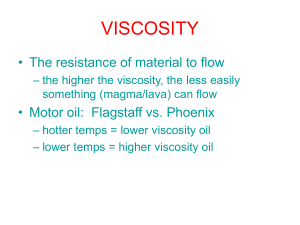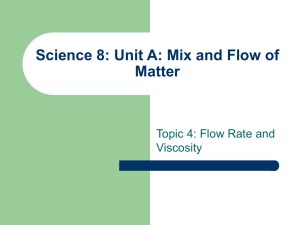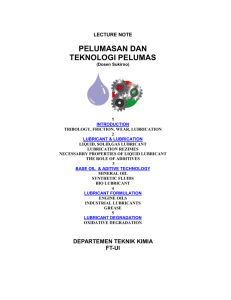13. Lubricating Oil For Paper Mill-Its Selection, Status of
advertisement
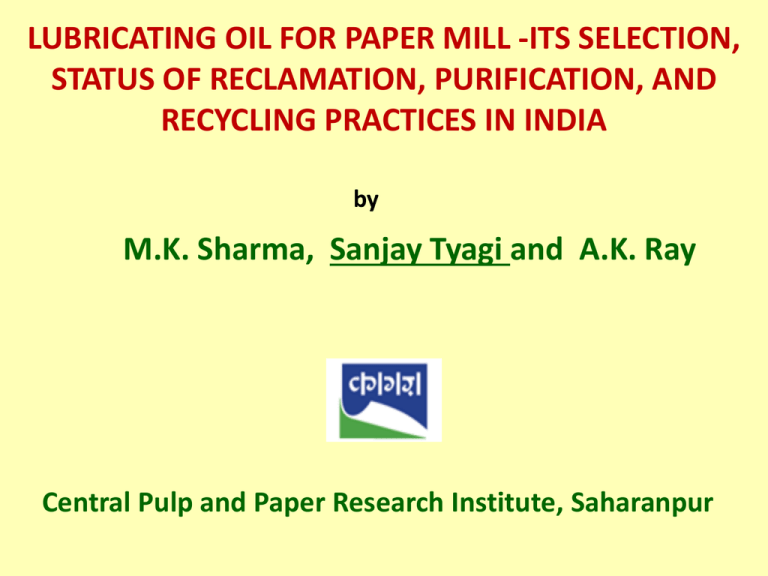
LUBRICATING OIL FOR PAPER MILL -ITS SELECTION,
STATUS OF RECLAMATION, PURIFICATION, AND
RECYCLING PRACTICES IN INDIA
by
M.K. Sharma, Sanjay Tyagi and A.K. Ray
Central Pulp and Paper Research Institute, Saharanpur
• Lubricants are chemical substances, derived oils
obtained
from
natural
resources
or
synthetic
materials used to carry the task of lubrication in an
engine or machine for any industry
• Used so as to reduce the risk of severity between two
sliding or rolling surfaces by developing the
smoothening film between them.
FUNCTION (OBJECTIVE OF LUBRICANTS)
• Lubricants reduces friction between sliding or
rolling surfaces and fatigue
• Surface wear and tear of machine
• Surface heat and act as coolant by reducing
temperature
• Maintenance and running cost
FUNCTION (OBJECTIVE OF LUBRICANTS)
• Interfacial deformation and expansion of
metals, absorbs shock.
• Avoids figure of moving surfaces, helps in
sealing the boundaries and
transmission.
• Improves the efficiency of machines.
• Prevent corrosion and rust.
in power
CHARACTERISTICS OF GOOD LUBRICATING OIL
• High boiling point
• Low freezing point
• Adequate stable viscosity for proper functioning in
service.
• High resistance to oxidation and heat (thermal
stability).
• Non-corrosive
prevention.
properties
and
corrosion
CHARACTERISTICS OF GOOD LUBRICATING OIL
• Stability to decomposition at the operating
temperatures,
• High viscosity index
• Hydraulic Stability
• Demulsibility
• Desired Flash Point and Fire Point, Cloud Point
and Pour Point and Aniline Point.
CLASSIFICATION OF LUBRICANTS
• Liquid lubricants or Lubricating Oils such as gear oil,
bearing oil, hydraulic oil etc.
• Semi-solid lubricants or Greases
• Solid lubricants. such as poly tetra fluro ethylene
(PTFE), hexagonal boron nitride,
and tungsten
disulfide are examples of materials that can be used
as solid lubricants , often to very high temperature.
Liquid lubricants or Lubricating oils
Lube oils are further classified into three
categories;
I. Animal and Vegetables oils,
II. Mineral or Petroleum oils and
III. Synthetic oils.
Animal and Vegetables oils
• Extracted from the crude fat and Vegetables oils such as
cotton seed oil and caster oils.
• Possess good oiliness and hence stick on metal surfaces
effectively even under elevated temperatures and heavy
loads.
• Suffered from the disadvantages of being costly, it undergo
easy oxidation to give gummy products and hydrolyze easily
on contact with moist air or water.
• Rarely used these days for lubrication.
Mineral or Petroleum oils
• Contain
90%
base
oil
(most
often petroleum fractions, called mineral oils) and
less than 10% additives.
• Basically lower molecular weight hydrocarbons with
about 12 to 50 carbon atoms.
• Cheap, available in abundance and stable under
service conditions, hence they are widely used.
Synthetic Lubricants
• Combination of synthetic base oil, additives plus
thickeners that provide a consistent set of desirable
characteristics for the wide range of performance.
• These are artificially synthesized from compounds
other than crude petroleum oil.
• Can used in such a diverse situation where
petroleum oil based lubricants do not provide the
excellent performance.
Synthetic Lubricants
• Provide natural lubricity, excellent low temperature
properties, high viscosity indices and better additive
compatibility.
• In addition, it can provide much better thermochemical and mechanical properties such as antioxidation, anti-corrosion, anti-friction, anti-wear and
extreme-pressure properties etc.
Additives
• Additives deliver reduced friction and wear, increased
viscosity,
improved
viscosity
index,
resistance
to corrosion and oxidation, aging or contamination, etc
• The main families of additives are: antioxidants, detergents,
anti-wear, metal deactivators, corrosion inhibitors, rust
inhibitors, friction modifiers, extreme pressure, anti-foaming
agents, viscosity index improvers, demulsifying/emulsifying,
stickiness improver, provide adhesive property towards tool
surface (in metalworking),and complexing agent (in case of
greases)
PHYSICO-CHEMICAL/ THERMAL PROPERTIES
Viscosity
•
Property of liquid by virtue of which it offers resistance to its own flow
(the resistance to flow of liquid is known as viscosity).
•
It is the most important single property of any lubricating oil, because it
is the main determinant of the operating characteristics of the lubricant.
•
If the viscosity of the oil is too low, a liquid oil film cannot be maintained
between two moving/sliding surfaces.
•
On the other hand, if the viscosity of the oil is too high, excessive friction
will result.
Effect of Temperature on Viscosity
•
The rate at which the viscosity of lubricating oil
changes with temperature is measured by an
arbitrary scale, known as Viscosity Index (V. I).
• If the viscosity of lubricating oil falls rapidly as the
temperature is raised, it has a low viscosity index.
On the other hand, if the viscosity of lubricating oil
is only slightly affected on raising the temperature,
its viscosity index is high
Effect of Temperature on Service Life
• As a rule of thumb, the service life of a mineral oil
is specified as 30 years at 30oC(85oF), 15 years at
40oC(105 oF), i.e the oil’s life is halfed for each
temperature increase of 10oC( 18 oF).
• At 100 oC (210oF) service life will be approximately
three months. One should use a synthetic oil at
temperature above 100oC (210oF).
Effect of Temperature on Service Life
Flash Point and Fire Point
• Flash point is the lowest temperature at which the lubricant
oil gives off enough vapors that ignite for a moment, when a
tiny flame is brought near it; while Fire point is the lowest
temperature at which the vapors of the lubricant oil burn
continuously for at least five seconds, when a tiny flame is
brought near it.
•
In most cases, the fire points are 5° C to 40° C higher than
the flash points.
Cloud Point and Pour Point
• When the lubricant oil is cooled slowly, the
temperature at which it becomes cloudy or hazy in
appearance, is called its cloud point
• while the temperature at which the lubricant oil cease
to flow or pour, is called its pour point.
• Cloud and pour points indicate the suitability of
lubricant oil in cold conditions.
Aniline point
• Aniline point of the lubricant oil is defined as the
minimum equilibrium solution temperature for
equal volumes of aniline and lubricant oil samples.
• It gives an indication of the possible deterioration of
the lubricant oil in contact with rubber sealing;
packing, etc.
LUBRICANT OIL SELECTION
• It should have a high viscosity index.
• It should have flash and fire points higher
than the operating temperature of the
machine.
• The cloud and pour points of a good lubricant
should always be lower than the operating
temperature of the machine.
• It should have higher aniline point.
LUBRICANT OIL SELECTION
• The volatility of the lubricating oil should be low.
• It should deposit least amount of carbon during
use.
• It should have good detergent quality
• It should have high oiliness.
• It should possess a higher resistance towards
oxidation and corrosion.
APPLICATIONS OF LUBRICANTS
• Lubricants are extensively employed in various
applications such as automotive engine oils, tractor ,
aviation, marine, agriculture and for personal use etc.
• For industrial use the most useful lubricants include
hydraulic oils, air compressor oils, food grade
lubricants, gas compressor oils, gear oils, bearing and
circulating system oils, refrigerator compressor oils,
steam and gas turbine oils.
ECONOMIC BENEFITS OF GOOD LUBRICATION
Results of audits of 229 industries in Japan showing the economic
benefits of using good lubricant
ECONOMIC BENEFITS OF GOOD LUBRICATION
Benefits obtained from studies on Indian industries
Benefits
Percentage
Reduction in energy consumption through lower
friction
Savings in lubricant cost
7.5%
Savings in maintenance, repair and replacement costs
20%
20%
Savings in consequential losses due to downtimedepending on type of failure and type of industry
Variable %
Savings in investment due to higher utilization ratio
and greater machine efficiency
1%
Savings in investment through increased life
Savings in manpower
5% of new
expenditure
0.13%
• Proper selection of oil viscosity / grease
thickness.
• Adequate viscosity reduction.
• Application of anti-wear / low friction
lubricant.
• Synthetic lubricant with high viscosity index
• Reduction of maintenance work ( oil change,
repair etc.
COMPARISON BETWEEN MINERAL OIL AND SYNTHETIC OIL: CASE
STUDIES
Causes for Energy saving by synthetic oil ,poly α-olefin (PAO)
• Viscosity –stable temperature characteristics( High viscosity
index), carbon chain is long and flexible
• High oxidation stability: there are no impurities such as S
and N , and good effect of addition of additive effect
• Low volatility and high flash point; molecular weight is
uniform and a few volatile component
• Low pure point; molecular weight is uniform and there is no
polymer which is easy to be solidified at low temperature
Viscosity as a function of temperature for PAO gear oil
Characteristics of gear oil-(Transmission efficiency) as a function of temperature
Oil color change while in use
Contamination level changed during operation
The superiority of synthetic oil over mineral oil is shown in figs. Above at
around 40oC.
∆E = (1/E ) {1-(1-E)[ηPAO/ηmineral oil]}0.3-1
where E=Transmission efficiency of gear =90% and ∆E= energy
saving effect.
Temperat
ure, 0C
Energy
saving
effect
0
5
10
25
2.7
2.3
1.8
1.0∆
LUBRICATING OIL USED IN INDIAN PAPER INDUSTRY
• Lubrication oil are used everywhere in any industry
,be it chemical, such sugar , paper , polymer, etc, ,
mechanical or metallurgical.
• Servo 140( 2,30400 Cps at 40oC) and servo 46(47.6 cps
at 40oC) are employed for mill turbine in sugar mill
• Servo 68 ( viscosity CPs at 40 oC varies between 55.9 to
68.1)
mill.
is used in power turbine in paper mill/ sugar
• In slow speed spur gear tooth breakage for reduction
of viscosity of gear oil( viscosity 14,800 CPs at 40oC at
the breakdown).
• It has been strongly felt that periodic checking
viscosity must be done after every 100 days.
• Thus timely analysis of viscosity of gear oil favorably
takes
care
controlling
of
preventive
maintenance,
thus
and saving of consumption of costly
petrochemicals and foreign exchange.
Characteristics of Lubricating Oils used in Indian Paper Industry
Product
Kinemtic
V.I. Flash Point
Viscosity
Min
°C Min
o
CST at 40 C
Application
Servo Prime
57
55-60
95
210
Servo prime oil used in hydraulic systems
requiring long life Lubricant of outstanding
properties.
Servo
System-320
(Circulating
Oils
315-350
90
230
Dryer cylinder Bearing, Pumps etc.
Servo
System-121
118-124
90
220
Particularly Compressors, Pumps etc.
Servo Mesh
SP-320
(Gear Oil)
320-350
90
232
Servo Mesh SP oil recommended for all heavy
duty enclosed gear drives with circulation or
splash lubrication system operating under heavy
or shock load conditions upto a temperature 100
oC
Servo Cyl
C460
460-480
90
280
Servo Cyl C oil are recommended for high temp.
above 100 oC. Servo Cyl C used in high temp.
Gear Box.
Oil Health Analysis
• Viscosity (kinematic viscosity), mm2/s, cst
• Total acid number, mg KOH/g
• Insoluble content, wt%
• Alkanity value: 0.1 N HCl ml/100 ml
• Demulsibility
• Foam stability
• Anti-rust property
• Consistency( Grease)
• Hydraulic fluid index(HFI)
Methods of Lubricating oil Analysis
PAPER INDUSTRY MAINTENANCE DIAGNOSIS
TECHNOLOGIES
• One of the examples of process of abnormal
lubrication and occurrence of machine trouble is oil
leakage.
• Others are level of contaminant, choice of bad
lubricant, abnormal load, temperature rise etc.
Preventing
oil
leakage
consumption significantly.
will
reduce
lubricant
HOW TO SELECT LUBRICANT OIL FOR
BEARING FOR PAPER INDUSTRY
•
Determine the bearing physical size (width, outer diameter,
inner diameter), element type (ball, cylindrical roller, spherical
roller, thrust ball or roller) and shaft speed.
•
Determine the bearing’s limiting speed factor. This value is
referred to as the “pitch line velocity” or the “nDm.”
•
Bearing speed limits differ for each bearing, but general rules
exist around bearings by bearing type and function.
Bearing speed limit parameters are calculated using
the following equation:
nDm = nx (ID+OD)/2
where ndm = pitch line velocity of the bearing
n = shaft speed
ID = bore diameter
OD = outside diameter
Bearing viscosity graph
Operating viscosity for mineral oils (with a VI of 100)
This information is particularly useful to assess
whether the bearing should be lubricated by oil or
grease. Equipment operators often convert oillubricated bearings to grease, even though the
operating speed of the bearing is beyond that which is
considered safe for grease lubrication. Grease type and
re-lubrication volumes and frequencies should be
adjusted to maintain bearing reliability under these
circumstances.
LUBE OIL PURIFACTION
• Ever-increasing
price of oil and with an objective of saving
valuable foreign exchange, every industry- user of mineral oil put
forward efforts for regeneration of used lubricating oil.
• Management of waste lube oil is a serious environmental
problem. Almost all types of waste oil have the potential to be
recycled safely, saving a precious non-renewable source and at
the
same
time
minimizing
environmental
Unfortunately, most of used oil is handled improperly.
pollution.
• In most cases, used oil can be re-used after
reconditioning with or without the addition of any
additives resulting in huge saving and conservation or
precious oil.
• Thus regeneration, reclamation or recycling of spent
lubricating oils has become an important process
industry,
adopting
purification.
various
techniques
for
oil
CONTAMINATION OR IMPURITIES OF USED
LUBRICATING OIL
• Metallic Impurities
• Non-metallic impurities
• Water, moisture and untreated acid
• Carboneous particles
• Fuels, impaired additives and their by products
• Chemical contaminates
• Polycyclic Aromatic Hydrocarbons(PHAs)
Reconditioning of waste lubricant ( thin film )
PRODCESS CHARACTERISTICS
Disadvantages
Advantages
1. Simple Process
2. Low Initial Investment
3. Low Energy Input
1. Unacceptable Process to Pollution
Control Boards
2. Generates Large Quantity of
Pollutants
3. Unable to treat Modern Multi-Grade
Oils,
4. Difficult to remove Asphaltic
Impurities
Reconditioning process vacuum distillation
CONCLUSIONS
• Lubricants are modified petroleum products or
derived
chemicals or synthetically manufactured not only reduce friction
and ease out maintenance ,but also reduce wear, absorb shock,
reduce temperature,
minimize corrosion and sealing out
contaminants.
• A good lubricant in general, therefore possesses characteristics
like high boiling point, low freezing point, high index, thermal
stability, hydraulic stability, demulsibility, corrosion prevention,
high resistance to oxidation and many others.
• Industry using oil based lubricant needs to identify its
use in specific machine and its component parts.
Hence its selection with specific characteristics is to
be identified and accordingly various additives have
to be added to comply with.
• Due to high price of oil and to save valuable foreign
exchange , there is an imperative necessity felt by the
mill to regenerate, reclaim, purify and recycle the
used oil.

